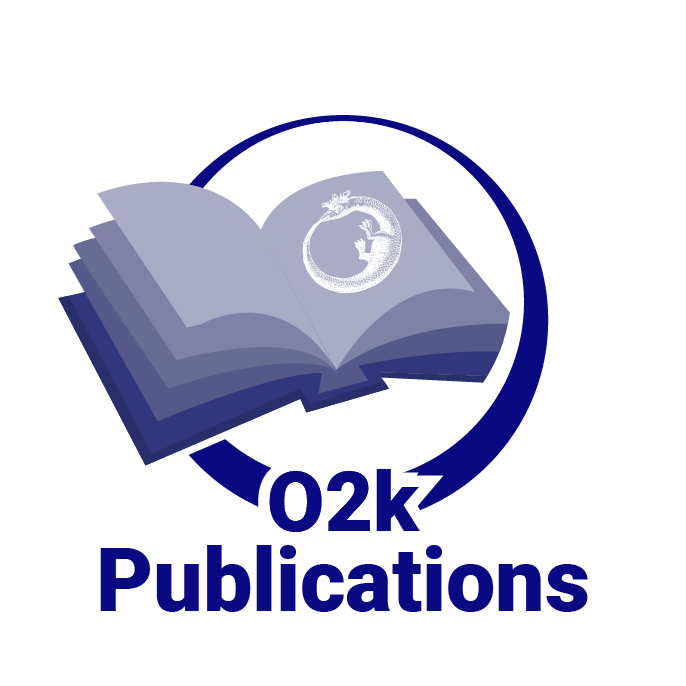O2k Applications
- O2k - the world's most Powerful, Popular and Prestigeous respirometer for cellular and mitochondrial research
High-Resolution Respirometry (HRR): O2k-Applications
Pathological states
- Aging;senescence
- Alzheimer's
- Autism
- Cancer
- Cardiovascular
- COPD
- Diabetes
- Inherited •• Infectious
- Myopathy
- Neurodegenerative
- Obesity
- Parkinson's
- Sepsis
- Other
Stress conditions
- Cell death •• Cryopreservation •• Hypoxia •• Ischemia-reperfusion injury and preservation •• Permeability transition •• Oxidative stress;RONS •• Temperature •• Cell death •• Mitochondrial disease;degenerative disease and defect
Mammals and models, other organisms
- Human •• Pig •• Horse •• Bovines •• Cat •• Dog •• Rabbit •• Mouse •• Rat •• Guinea pig•• Other mammals
- Chicken •• Zebrafish •• Drosophila •• Caenorhabditis elegans •• Artemia •• Saccharomyces cerevisiae
- Comparative MiP •• Plants
- Further information
Tissues, cell types and cell lines
- Heart •• Skeletal muscle •• Nervous system •• Liver •• Kidney •• Lung; gill •• Fat •• Genital •• Endothelial;epithelial;mesothelial cell •• Islet cell;pancreas;thymus •• Blood cells
- CHO •• HEK •• HeLa •• Neuroblastoma •• Fibroblast •• HUVEC •• Macrophage-derived cell lines •• Lymphocyte •• Platelet •• Stem cells •• Other cell lines
Preparations
- Intact organism •• Intact organ •• Intact cells •• Permeabilized cells •• Permeabilized tissue •• Homogenate •• Isolated mitochondria •• SMP •• Chloroplasts •• Enzyme •• Oxidase and biochemical oxidation
Regulation
- ADP •• ATP production •• Aerobic glycolysis •• Amino acid •• Calcium •• Coupling efficiency;uncoupling •• Cyt c •• Fatty acid •• Flux control •• Inhibitor •• Ion;substrate transport
- mt-Membrane potential •• O2 •• Oxygen kinetics •• Redox state •• Temperature •• Threshold;excess capacity •• Substrate •• Uncoupler·
Enzymes
- Adenine nucleotide translocase •• Complex I •• Complex II;succinate dehydrogenase •• Complex III •• Complex IV;cytochrome c oxidase •• Complex V;ATP synthase •• Inner mt-membrane transporter •• Marker enzyme •• Supercomplex •• TCA cycle and matrix dehydrogenases •• Uncoupling protein
MiPMap combinations - examples
Examples for specific combinations are given for O2k-Publications:
- O2k-Publications: Human skeletal muscle
- O2k-Publications: Human heart
- O2k-Publications: Skeletal muscle - human vs mouse
O2k-Manuals and protocols and specific instrumental applications
- O2k-Manual •• Instruments;methods •• TIP2k •• O2k-Fluorometry •• Theoretical background •• O2k-Protocols •• Q-junction effect
For more applications, browse through the O2k-Publications
High-Resolution: high accuracy, minimum amount of sample
| Sample | Amount | O2k-Chamber | Temp. |
|---|---|---|---|
| Heart mitochondria | 0.01 mg protein | 2.0 ml | 37 ° C |
| Permeabilized muscle fibers | 1 mg wet weight | 2.0 ml | 37 ° C |
| Endothelial cells | 0.2 • 10^6 cells | 2.0 ml | 37 ° C |
| T-lymphocytes | 1 • 10^6 cells | 2.0 ml | 37 ° C |
Reference: Pesta 2012 Methods Mol Biol
Rapidly Increasing Demands
Approaches to mitochondrial and cellular respirometry have been transformed and extended in mitochondrial physiology, from specialized bioenergetics to integrative and clinical applications. Meeting rapidly increasing demands, the new OROBOROS Oxygraph-2k (O2k) covers major areas of interest:
1. Routine analysis of oxidative phosphorylation (OXPHOS) in diverse fields of research such as redox signaling, oxidative stress 1, ischemia-reperfusion 2, aging 3, degenerative and inherited diseases 4; apoptosis, cancer research and drug testing 5, cell signaling 6, and environmental stress. For the non-specialist, the O2k provides robustness and reliability of instrumental performance. Full software support by DatLab includes automatic oxygen calibration, continuous display of oxygen concentration and respiratory flux, and on-line tabulation of final results on OXPHOS activity during selected experimental sections. Standardized O2k quality controls eliminate interferences by instrumental artifacts. Long-term stability of the polarographic oxygen sensors ensures the O2k to be ready to use (no exchange of membranes and electrolyte for months).
2. High throughput is required in research with cell cultures and pharmacological tests. The O2k has two independent chambers for parallel experimental runs. User-friendly features make it possible to apply several O2k simultaneously.
3. Diagnosis of OXPHOS in living and permeabilized cells, small amounts of tissue from transgenic animal models, and human needle biopsies requires high-resolution respirometry to obtain accurate results even at high sample dilution. <1 mg fresh muscle tissue or <500.000 cells are required per chamber (10-fold less compared to conventional instruments). Multiple substrate/inhibitor titration protocols extend the information gained on various OXPHOS complexes in a single incubation.
4. Prevalence of oxidative stress at air-level oxygen tensions demands a shift to physiological low-oxygen ranges for studying OXPHOS [www.pnas.org/cgi/content/full/97/20/11080| 7], 8.
5. O2k-MultiSensor applications (pH, NO, H2O2, ion sensitive electrodes), and sampling from the chamber (CS enzyme assays; EPR spin probes for ROS) extend the diagnostic power of high-resolution respirometry.
This makes the OROBOROS Oxygraph-2k the world-wide unique instrument for high-resolution respirometry:
- Chamber design: avoiding oxygen-permeable materials such as Perspex or teflon-coated stirrers 7 Compare: O2k versus multiwell respirometer
- Instrumental concept: including integrated Peltier-temperature control, automatic Titration-Injection microPump TIP2k
- Methodological standards




